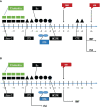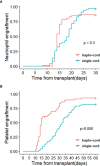Sequential Transplantation of Haploidentical Stem Cell and Unrelated Cord Blood With Using ATG/PTCY Increases Survival of Relapsed/Refractory Hematologic Malignancies
- PMID: 34804017
- PMCID: PMC8599442
- DOI: 10.3389/fimmu.2021.733326
Sequential Transplantation of Haploidentical Stem Cell and Unrelated Cord Blood With Using ATG/PTCY Increases Survival of Relapsed/Refractory Hematologic Malignancies
Abstract
Allogeneic haploidentical HSCT (haplo-HSCT) and unrelated umbilical cord blood transplantation(UCBT)are used in patients lacking HLA-identical sibling or unrelated donors. With myeloablative condition and GVHD prophylaxis of using low-dose ATG and post-transplantation cyclophosphamide (PTCY), we conducted a prospective clinical trial. Of eligible 122 patients from February 2015 to December 2019 in the study, 113 patients were involved. Forty-eight patients were in the group of sequential haplo-cord transplantation (haplo-cord HSCT), and 65 patients were in the group of single UCBT. The primary endpoint of 2-year disease-free survival (DFS) was no statistical difference between groups (64.1 vs. 56.5%), p>0.05. The analysis of subgroup patients with relapsed/refractory showed haplo-cord HSCT was associated with better OS (HR 0.348, 95% CI, 0.175-0.691; p=0.0025), DFS (HR 0.402, 95% CI, 0.208-0.779; p=0.0069), and GRFS (HR 0.235, 95% CI, 0.120-0.457, p<0.0001) compared to the single cord group. The 2-year's probability in OS, DFS, and GRFS was 64.9 vs. 31.6%, 64.5 vs. 31.6%, and 60.8 vs. 15.0% in the haplo-cord group and single cord group, respectively. III-IV acute GVHD 8.3 vs. 6.2%, chronic GVHD 25.8 vs. 13.7%, and extensive chronic GVHD 5.3 vs. 1.8% were shown in corresponding group, p>0.05. The patients engrafted persistently with UCB showed better survival outcomes. Our sequential Haplo-cord HSCT with ATG/PTCY improved the survival of patients and might be an alternative transplantation approach for patients with relapsed/refractory hematologic malignancies.
Keywords: low-dose ATG; post-transplant cyclophosphamide; relapsed/refractory hematologic malignancies; sequential transplantation; umbilical cord blood transplantation.
Copyright © 2021 Li, Li, Chen, Li, Chen, Zhu, Wang, Huang, Chen, Chen and Li.
Conflict of interest statement
The authors declare that the research was conducted in the absence of any commercial or financial relationships that could be construed as a potential conflict of interest.
Figures





References
-
- Canaani J, Beohou E, Labopin M, Ghavamzadeh A, Beelen D, Hamladji RM, et al. . Trends in Patient Outcome Over the Past Two Decades Following Allogeneic Stem Cell Transplantation for Acute Myeloid Leukaemia: An ALWP/EBMT Analysis. J Intern Med (2019) 285(4):407–18. doi: 10.1111/joim.12854 - DOI - PubMed
-
- Shouval R, Fein JA, Labopin M, Kroger N, Duarte RF, Bader P, et al. . Outcomes of Allogeneic Haematopoietic Stem Cell Transplantation From HLA-Matched and Alternative Donors: A European Society for Blood and Marrow Transplantation Registry Retrospective Analysis. Lancet Haematol (2019) 6(11):e573–84. doi: 10.1016/S2352-3026(19)30158-9 - DOI - PubMed
Publication types
MeSH terms
Substances
LinkOut - more resources
Full Text Sources
Research Materials

